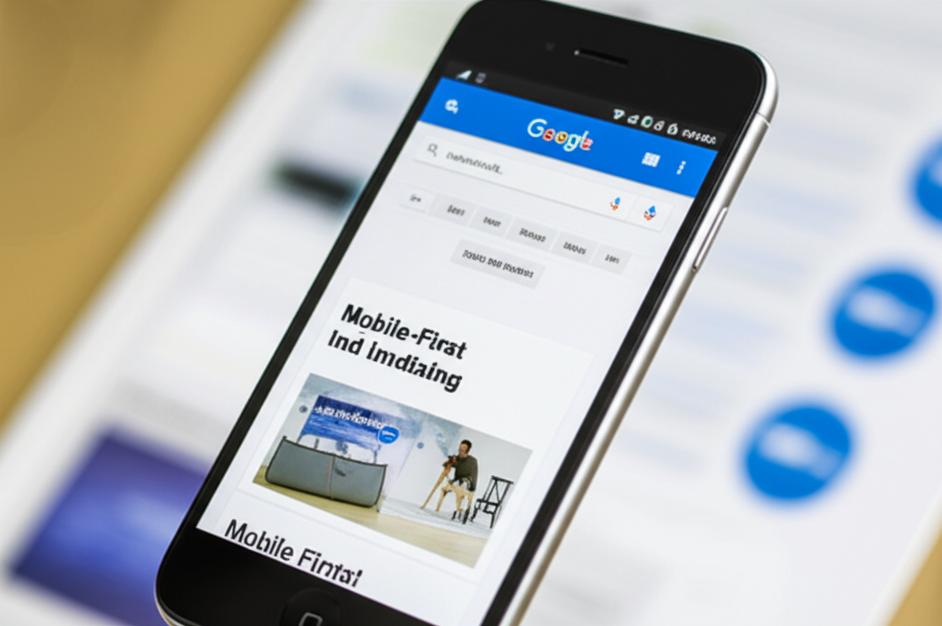Mobile-First Indexing: Optimizing Your Website for Mobile Dominance

Mobile-First Indexing: A Comprehensive Guide
Nội dung
- 1 Mobile-First Indexing: A Comprehensive Guide
- 1.1 What is Mobile-First Indexing?
- 1.2 Why Mobile-First Indexing Matters
- 1.3 Who is Affected by Mobile-First Indexing?
- 1.4 When Did Mobile-First Indexing Start?
- 1.5 Where to Start Optimizing for Mobile-First Indexing?
- 1.6 Optimizing for Mobile Speed
- 1.7 Common Mobile-First Indexing Mistakes to Avoid
- 1.8 Monitoring Your Mobile-First Indexing Performance
- 1.9 Ebiz and Mobile Optimization
- 1.10 Conclusion
- 1.11 Chia sẻ:
- 1.12 Thích điều này:
In today’s digital landscape, mobile devices have become the primary way users access the internet. Google recognized this shift and implemented mobile-first indexing, a significant change in how websites are ranked and indexed. This article will explore what mobile-first indexing is, why it matters, and how to optimize your website to thrive in this mobile-centric environment.
What is Mobile-First Indexing?
Mobile-first indexing means that Google primarily uses the mobile version of a website for indexing and ranking. Previously, Google primarily used the desktop version of a page’s content to evaluate its relevance to a user’s query. However, as mobile usage surpassed desktop usage, Google shifted its focus to the mobile version. This ensures that the search engine is evaluating the version of the website that most users are experiencing.
Essentially, Googlebot, Google’s web crawler, now prioritizes crawling and indexing the mobile version of your site. If you have a responsive website or a separate mobile site, Google will use the mobile version to understand your content and determine its ranking. If you don’t have a mobile-friendly site, your rankings could be negatively impacted.
Why Mobile-First Indexing Matters
Understanding the importance of mobile-first indexing is crucial for maintaining and improving your website’s search engine optimization (SEO) performance. Here’s why it matters:
- SEO Ranking: Google uses the mobile version of your site to determine your search engine rankings. If your mobile site is slow, lacks content, or provides a poor user experience, your rankings can suffer.
- User Experience: A positive mobile experience is essential for engaging users and encouraging conversions. Mobile-first indexing reinforces the need for a seamless and user-friendly mobile website.
- Increased Mobile Traffic: With more users accessing the internet via mobile devices, optimizing for mobile-first indexing can help you capture a larger share of mobile traffic.
- Future-Proofing: Mobile usage will only continue to grow. Optimizing for mobile-first indexing ensures your website is prepared for the future of search.
Who is Affected by Mobile-First Indexing?
Mobile-first indexing impacts virtually all websites. However, the degree of impact depends on how well your website is optimized for mobile devices. Here’s a breakdown of how different websites are affected:
- Responsive Websites: Websites with responsive designs generally fare well in mobile-first indexing. Responsive designs automatically adjust to different screen sizes, providing a consistent user experience across devices. If your responsive site provides all the content available on your desktop site, you’re likely in good shape.
- Separate Mobile Sites (m.example.com): Websites with separate mobile sites need to ensure that the mobile version contains the same content and structured data as the desktop version. Redirects and canonical tags must be correctly implemented.
- Websites That Aren’t Mobile-Friendly: Websites that are not mobile-friendly are most at risk. These sites may experience a significant drop in search engine rankings.
When Did Mobile-First Indexing Start?
Google officially started rolling out mobile-first indexing in 2018. The process has been gradual, with Google continuing to migrate websites to mobile-first indexing over time. By 2020, Google had enabled mobile-first indexing for the majority of websites. While the rollout is largely complete, it’s still essential to ensure your website is fully optimized for mobile.
Where to Start Optimizing for Mobile-First Indexing?
Optimizing for mobile-first indexing requires a comprehensive approach. Here’s a step-by-step guide to help you get started:
- Mobile-Friendly Test: Use Google’s Mobile-Friendly Test (https://search.google.com/test/mobile-friendly) to check if your website is mobile-friendly. This tool will identify any issues that need to be addressed.
- Responsive Design: If your website isn’t already responsive, consider redesigning it to be responsive. This is the best approach for providing a seamless user experience across all devices.
- Content Parity: Ensure that the mobile version of your website contains the same high-quality content as the desktop version. Don’t hide content on mobile to simplify the design. Use techniques like accordions or tabs to present content in a mobile-friendly way.
- Structured Data: Verify that your structured data (schema markup) is present and consistent on both the mobile and desktop versions of your website. Structured data helps Google understand the content on your pages.
- Mobile Site Speed: Optimize your mobile site for speed. Use Google’s PageSpeed Insights (https://developers.google.com/speed/pagespeed/insights/) to identify speed bottlenecks and implement optimizations such as image compression, code minification, and browser caching. Consider using a Content Delivery Network (CDN) to serve your content from servers closer to your users.
- Mobile Usability: Ensure that your mobile site is easy to navigate and use. Pay attention to factors such as font size, button size, and spacing. Avoid using intrusive interstitials (pop-ups) that can negatively impact the user experience.
- Viewport Meta Tag: Use the viewport meta tag to control how your website scales on different screen sizes. The recommended viewport meta tag is:
<meta name="viewport" content="width=device-width, initial-scale=1.0"> - Mobile-Friendly Interstitials: If you use interstitials on your mobile site, make sure they are mobile-friendly. Avoid using full-screen interstitials that block the main content of the page. Instead, use smaller, less intrusive interstitials.
- Image Optimization: Optimize your images for mobile devices. Use compressed image formats like WebP and resize images to fit smaller screens. Implement lazy loading to defer the loading of images until they are visible in the viewport.
- Video Optimization: Optimize your videos for mobile devices. Use responsive video players and compress videos to reduce file size. Consider using a video CDN to deliver your videos from servers closer to your users.
- Test Your Mobile Site: Regularly test your mobile site on different devices and browsers to ensure that it is working correctly. Use browser developer tools to simulate different screen sizes and network conditions.
Optimizing for Mobile Speed
Site speed is a critical ranking factor, especially on mobile devices. Users expect fast loading times, and slow loading speeds can lead to high bounce rates and lost conversions. Here are some strategies for optimizing your mobile site speed:
- Optimize Images: Compress images without sacrificing quality. Use tools like TinyPNG or ImageOptim to reduce image file sizes.
- Minify Code: Remove unnecessary characters from HTML, CSS, and JavaScript files. Use tools like UglifyJS or CSSNano to minify your code.
- Enable Browser Caching: Use browser caching to store static assets on users’ devices. This reduces the number of requests that need to be made to the server.
- Use a Content Delivery Network (CDN): A CDN stores your website’s content on servers around the world. This allows users to download content from a server that is closer to them, resulting in faster loading times.
- Reduce HTTP Requests: Minimize the number of HTTP requests that your website makes. Combine CSS and JavaScript files, and use CSS sprites to combine multiple images into a single image.
- Prioritize Visible Content: Load the content that is visible in the viewport first. Use lazy loading to defer the loading of content that is below the fold.
- Choose a Fast Hosting Provider: Your hosting provider can have a significant impact on your website’s speed. Choose a hosting provider that offers fast servers and reliable uptime.
Common Mobile-First Indexing Mistakes to Avoid
- Blocking Googlebot: Make sure that you are not blocking Googlebot from accessing your mobile site. Use the robots.txt file to allow Googlebot to crawl your site.
- Content Mismatch: Ensure that the content on your mobile site is the same as the content on your desktop site. Don’t hide content on mobile to simplify the design.
- Missing Structured Data: Verify that your structured data (schema markup) is present and consistent on both the mobile and desktop versions of your website.
- Slow Mobile Site Speed: Optimize your mobile site for speed. Use Google’s PageSpeed Insights to identify speed bottlenecks and implement optimizations.
- Poor Mobile Usability: Ensure that your mobile site is easy to navigate and use. Pay attention to factors such as font size, button size, and spacing.
Monitoring Your Mobile-First Indexing Performance
After implementing mobile-first indexing optimizations, it’s crucial to monitor your website’s performance. Here are some tools and metrics to track:
- Google Search Console: Use Google Search Console to monitor your website’s mobile usability, crawl errors, and index coverage. Google Search Console will also notify you if Google has switched your website to mobile-first indexing.
- Google Analytics: Use Google Analytics to track your website’s mobile traffic, bounce rate, and conversion rate. This will help you understand how users are interacting with your mobile site.
- PageSpeed Insights: Use PageSpeed Insights to monitor your website’s mobile site speed. This tool will provide you with recommendations for improving your site’s speed.
- Rank Tracking: Monitor your website’s search engine rankings for mobile keywords. This will help you determine if your mobile-first indexing optimizations are working.
Ebiz and Mobile Optimization
While Ebiz primarily focuses on POS (Point of Sale) software, it indirectly relates to mobile optimization. A business using Ebiz might also have an online store or website to complement their physical store. Ensuring this online presence is mobile-friendly is vital for capturing customers who discover the business through mobile search.
Ebiz isn’t directly used for website optimization, but a business utilizing Ebiz should ensure their associated website is optimized for mobile-first indexing. Software commonly used in conjunction with Ebiz and relevant to mobile optimization include:
- Google Analytics: To track mobile traffic and user behavior.
- Google Search Console: To monitor mobile usability and crawl errors.
- PageSpeed Insights: To assess and improve mobile site speed.
Conclusion
Mobile-first indexing is a critical aspect of SEO in today’s mobile-dominated world. By understanding what it is, why it matters, and how to optimize your website, you can improve your search engine rankings, enhance user experience, and drive more mobile traffic. Regularly monitor your website’s performance and stay up-to-date with the latest mobile SEO best practices to maintain a competitive edge.
Ready to optimize your business for success? Visit our store and explore our POS solutions:
https://www.phanmempos.com/cua-hang

